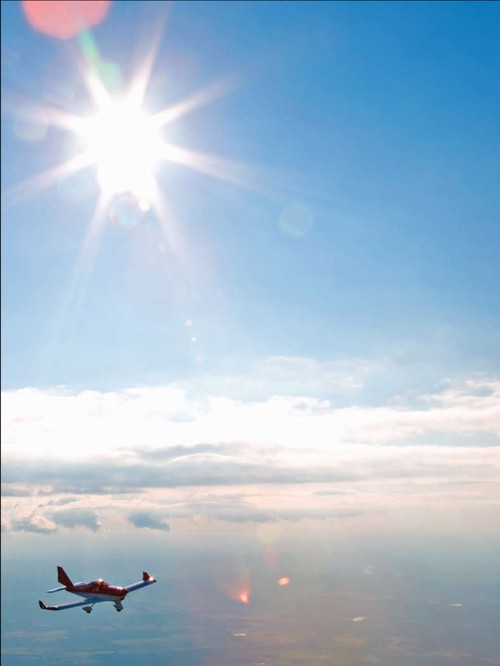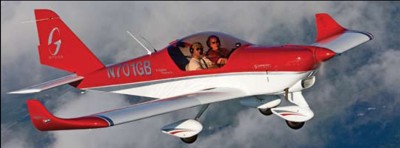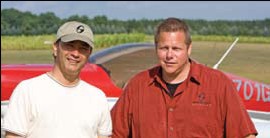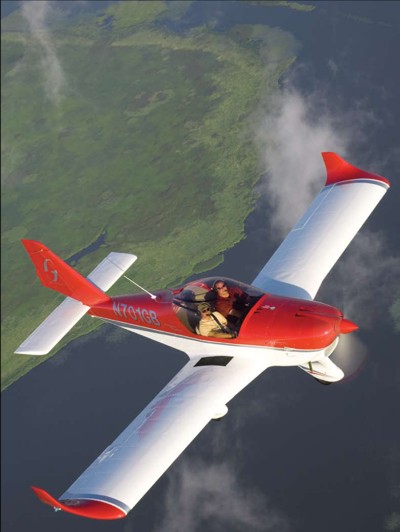


Gobosh principals Tim Baldwin,
right, and Dave Graham like to
call the G-700S a luxury, rather
than light sport aircraft (LSA).

Gobosh airplanes feature a “sixpack”
of standard instruments, plus
a radio, transponder, and GPS.

Swept wingtips and 31 inches of
additional wingspan not only add
eye appeal, but also bring its stall
speed to within LSA limits.

This image shows the split flaps,
the large horizontal stabilizer,
and forward-tilting canopy, which
can be removed completely for
emergency egress.

The cockpit is 41 inches wide.
Two-tone leather seats are
standard in the Gobosh Elite
model. A Johnson bar between
the seats deploys the split flaps.

This compartment can hold up to
44 pounds and is designed to fit
a pilot’s chart bag.

Seven access panels, such as
this one at the elevator push rod
assembly, allow easy viewing of
critical areas of inspection.


Aero LTD.
To Gobosh, LSA Means “Luxury Sport Aircraft”
Are luxury and light-sport aircraft (LSA)
compatible terms? Why shouldn’t they be? Some
automobiles are basic transportation machines
while others are luxurious, high-end cruisers.
That same variety can and should exist in the
world of aircraft, offering owners choices in
both price and “finish” of an airplane.
With luxury in mind,
one of the newer
entrants into the LSA
field, Gobosh Aviation,
introduced the Gobosh
G-700S to the U.S. market at EAA
AirVenture Oshkosh 2007. Built in
Poland by Aero Ltd. (see sidebar)
the G-700S is modified from Aero’s
AT-3, which has been produced
under European Joint Airworthiness
Requirements-Very Light Aircraft
(JAR-VLA) since 1999. About 30 AT-3s
are flying in Europe
What’s with Gobosh? What kind of
company name is that, you ask? Well,
Gobosh stands for “go big or stay
home.” One of Gobosh’s investors
hails from the high-tech computer
industry, and that’s his slogan in that
fast-paced, breakthrough-focused
world. For a new airplane company
in an exploding new market segment,
the name seemed a good fit.
Are you getting the idea that
Gobosh principals Dave Graham
and Tim Baldwin are doing things
differently than others in light-sport
aviation? Yes, they are. With some
59 approved special light-sport
aircraft (S-LSA) from 47 companies
currently available, a relatively
new entry like Gobosh needs to
do things a little differently to set
itself apart. Dave and Tim were
formerly associated with Symphony
Aircraft Ltd. Wanting to continue
to use their business experience
to pursue an aviation enterprise,
they developed Gobosh and sought
investors and U.S. distribution
rights for the AT-3.
AT-3 to G-700S
The AT-3 was certified under the
European Union’s Very Light Aircraft
(VLA) standard, which Dave feels is
equivalent to FAR Part 23, though
JAR-VLA does not permit flight in
instrument conditions. Gobosh
and Aero Ltd. evolved the design to
comply with both JAR-VLA and the
ASTM S-LSA consensus standards.
Some changes were made to the
wing and cockpit. The most obvious is
a vertical wingtip that adds a modern
look. Additionally the G-700S wing
has 80 centimeters (31 inches) more
span to assure the airplane would meet
the required LSA stall speed and have
enough wing area for the LSA category’s
1,320-pound maximum gross weight.
“The wing changes required a lot of
work, as the handling and stability required by the ASTM standard needs
to be positive, that is, tending back
towards equilibrium,” Dave said.
An all-new instrument panel for the
G-700S model comes with the “sacred
six” instruments-airspeed, altitude,
and rate of climb indicators, turn rate
coordinator, artificial horizon, and
directional gyro-normally used in
an instrument flying scan. Toe brakes
were added to appeal to American
general aviation (GA) pilots, and
other small modifications were made
for American tastes.
“The AT-3 and G-700S are different
aircraft,” Dave emphasized. “The
G-700S is based on the AT-3, but
there are a lot of differences between
the aircraft. The panel and cockpit
layout is substantially different; it
has different avionics, and switch
positions are different, as is the layout
of the center console.”
Dave continued, “We paid a lot
of attention to detail on the aircraft:
large access panels for maintenance;
easy seat removal for access to control
parts; and seven tool-free panels,
which reduces paint chipping, lost
screws, and misplaced panels during
maintenance.”
The seven access panels permit
inspection of the aileron pushrods
in the wings, the elevator pushrod
under the baggage compartment, the
rear bulkhead, the elevator pushrod
(access at the tailskid), and two flap
torque tube inspection points under
the fuselage. The spring-loaded
latches require no tools to open.
Access to the engine and/or
instrument panel was also made easy
for maintenance purposes. Simply
remove the upper cowling, made of
lightweight carbon and Kevlar, and
a secondary cowl aft of the engine
cowling near the fuel fill point. There
are a lot of screws, but once the cowls
are off, you can access the engine and
all panel instruments much easier
than many designs that require you to
twist under the panel from the inside.
The fuel cap is located in the center
of the nose of the aircraft, ahead of the
cockpit, and the fuel tank cap comes
with a built-in dipstick. The fuel fill
location allows convenient access,
but it appears to permit any spilled
fuel to flow toward the canopy.
More Refinements
Inside, the G-700S has a 41-inch wide
cabin, offering more shoulder room
than the benchmark Cessna 172
Skyhawk, which Cessna lists at 39.5
inches, but less than several other
LSA designs.
The G-700S has two baggage areas,
one of which is lockable and located
just aft of the pilot’s seat. It is quite
deep and was designed to hold a
pilot’s chart bag and up to 44 pounds.
A smaller area can hold 22 pounds,
including hat rack items. Every pilot
has dropped a pen or something on
the floor and groped around for it
while flying. In the G-700S, nothing
will move aft under the seats as a
bulkhead prevents such movement.
The G-700S comes standard with a
tinted canopy. Canopy latches on each
side allow the canopy to tilt forward,
while a canopy release disengages
a pin where the gas-assist pistons
connect to the canopy, permitting it
to be released for emergency egress. It
could also be removed to aid control
panel access. What appears to be an
air inlet at the back of the canopy is
actually an exhaust vent.
When entering the cockpit, the
G-700S has a number of strong
handholds: the aft fuselage bulkhead,
the seat back, and the instrument
panel are all sufficiently robust.
However, you cannot use the canopy
for support.
Dave reported that Gobosh surveyed
prospective customers and found that
most desired a “standard six pack”
of instruments. These are not gauges
with technical standards orders (TSO),
though that seems an easy way to
make G-700S an instrument-capable
airplane. However, Dave doesn’t feel
the airplane is suited to this usage,
so the company doesn’t promote this
capability. GPS and radios are stacked
to the right, separated from flight
instruments by a series of engine
gauges. “All Gobosh airplanes come
equipped standard with the six-pack
of instruments, a radio, transponder,
and GPS unit,” said Dave.
Aero Ltd.’s designers buried the
GPS antenna underneath the main
engine cowl. You’ll discover this when
removing that cowling for engine
maintenance.
The G-700S uses split flaps. You
cannot see their position from the
cockpit, but the flap handle is marked
for 15 and 40 degrees of extension.
The hand lever is a Johnson bar,
which allows easy and familiar flap
deployment. All Gobosh G-700S are
equipped with carb heat, a cowl door to
help control oil heat, and a fuel shut-off.
A panel knob controls the volume of air
supplied to four cabin outlets, which
did a good job on the warm day I flew
the airplane. For cold days, the G-700S
has a 12-volt access point should engine
jump-starting be necessary.
The G-700S undercarriage has a
steel spring landing gear. “It’s built
tough for longevity,” reported Dave.
Standard aircraft tires are supplied in
5.00-5 dimensions and work well on
smooth surfaces, but they may be
small for grass/off-field operations.
Tie-down rings are located at the
wingtips, and the airplane has jack
points inside the wheels. Another
clever design is a tow bar that doubles
neatly as an interior gust lock. You
position it to press down against the
rudder pedals and back up against the
joystick using a ratchet. Small and
light, it appeared to securely hold all
movable surfaces. You can place the
lower end against the toe brakes to
effectively lock the wheels as well.
Let’s Go Skyward
During EAA AirVenture Oshkosh
2007, I flew N702GB, serial number
2, with company demo pilot
Tony Settember. Gobosh fielded
three aircraft at AirVenture 2007,
representing 100 percent of its LSA
fleet at the time.
On taxiing, I found the G-700S’
brakes to be potent. The toe brakes,
with directional braking in concert
with a castoring nose wheel, allowed
tight maneuvering. When we returned
to Gobosh’s designated parking space
on Fond du Lac County Airport, from
which Gobosh was making its demo
flights, Tony pivoted the airplane
smartly into position.
Once cleared by the temporary
tower at Fond du Lac, our G-700S
accelerated smoothly to a rotation
speed of 41 knots. I estimated a
500-foot roll. Climb was performed
at 60 knots. Best rate of climb is at
58 knots, which produces about 800
fpm of climb.
I was able to hold steep turns easily
at 5000 to 5200 rpm without running
out of back-stick range. Though I
easily controlled the turns in either
direction, I tended to climb a bit
when executing to the right, which
is normal when flying a side-by-side
design from the left seat. I felt the
joystick was moderately on the heavy
side, though this may be perfect for
many pilots. Rudder pedal pressures
felt slightly lighter, though leg versus
arm movements differ. Dutch rolls
went well at normal cruise speeds,
but the maneuver felt a little sluggish
at slow speeds, as you’d expect.
Maneuvering speed is 92 knots, and
the green arc tops out at 110 knots.
All these figures put the G-700S in
about the middle of the performance
range among all S-LSA.
Fast and Steady G-700S
Maximum speed runs done on a
westerly heading showed 120 knots
and 112 knots when done to the
east, averaging 116 knots. This was
done at about 2,500 feet AGL with
the outside air temperature at 75°F.
The 116-knot figure is precisely what
is shown on Gobosh literature for
the G-700S.
Based on my observations, Gobosh’s
printed performance numbers tend to
be slightly conservative. “This is part
of the ethos of both Gobosh and Aero,
to under promise and over deliver,”
Dave said. “We also publish our empty
weight as a fully equipped aircraft,
that is, with radio, transponder, GPS,
three gyro instruments (heavy), all
instruments, VOR, wheelpants, twotone
paint, and all unusable fluids
included. If we published empty
weights in the same manner as some
of our competitors including only
basic instruments, no wheelpants,
cloth interior, and unpainted finish,
we’d have an additional 45 pounds of
useful load. However, this is not our
philosophy. Anybody should be able
to purchase a fully equipped aircraft
at the weight we publish.”
Gobosh prides itself on a wellequipped,
ready- to- f ly special
light-sport aircraft. However, that
thoroughness and attention to detail
comes with some weight penalty.
With full fuel (18.5 gallons) the
G-700S has a payload of 389 pounds,
good for two generously sized
occupants without baggage.
Tony likes to do maneuvering
work at about 4500 rpm, while
we ran about 5000 rpm for much
of the flight review flying. At this
lower setting, speed drops, of course,
but cabin noise was tolerable even
without headsets. Heating wasn’t an
issue, but the day was warm not hot.
I did my full regimen of stalls
and found excellent behavior from the G-700S. In power-on departure
stalls, power-off approach stalls, and
steeply banked accelerated stalls, I
noted mild characteristics with no
break whatsoever. Even when poweroff
approach stalls were aggravated
with a more aggressive pull on the
joystick, I was not able to upset the
good manners of the aircraft.
In my longitudinal stability check,
the up and down oscillations maxed
out at 110 knots and decreased to
75 knots. In each oscillation, about
5 knots came off these extremes in
a predictable manner. However, I
did observe some wandering of the
nose during this exercise. Response
to power up or down from level
flight was positive in both directions.
Mild stalls and conventional pitch
behavior reinforce the flight trainingcapabilities
of the airplane.
Later, when we came around
for landing, final approach was
at 55 knots with full flaps. Tony
recommended 60 knots if you deploy
only half-flaps.
We flew on a smooth, pleasant day,
but even without turbulence, G-700S
felt solid and secure in all maneuvers.
It’s a confidence-inspiring airplane. It
should suit a training environment or
most recreational flying, though few
would call G-700S a fast-responding
airplane.
A Luxury Sport Aircraft for You?
Perhaps it’s shrewd marketing, but
Gobosh has positioned the G-700S
as a luxury sport aircraft (their own
adaptation of LSA). Does that mean
you can’t afford one? Not really.
Gobosh offers three versions of
the G-700S: a Sport Edition, Elite
Edition, and Elite Plus Edition. Each
one has more stuff, of course, but
even the base unit is nicely equipped
and includes the tow bar/gust lock,
stall-warning indicator and horn,
wheelpants, delivery from Europe,
and FAA registration. Oftentimes
these costs are presented after a base
price quote. The Gobosh’s prices
represent a well-equipped flyaway
airplane.
The Sport retails for $106,900
with a 100-hp Rotax, threeblade
prop, six-pack instruments,
transponder, intercom, comm
radio, Garmin 296, leather seats,
two-year or 400-hour warranty,
and white with vinyl stripes paint
scheme. This is a good value, and
financing is available. Put $21,000
down and pay $695 a month on
a 20-year program based on a 7.6
percent interest rate. The Sport is
equipped for day VFR flight only.
The Elite Edition, for $116,850,
adds two-tone leather seats and custom two-tone paint (red or blue).
It also adds night VFR capability.
The Elite Plus Edition, for $123,900,
adds a Garmin SL30 nav/comm with
course deviation indicator, Garmin 496
with XM Weather, and Beyerdynamic
headsets. Financing starts with $25,000
down and $750 a month over 20 years
at 6.7 percent interest. As with many
finance plans, the loan term is five
years, and the interest rate may be
altered at that interval.
Each G-700S aircraft should enjoy
a long life, as structural parts are
anodized aluminum, which Gobosh
considers superior to zinc chromate
corrosion proofing. Additionally, all
steel parts are cadmium-plated.
Dave indicated that Gobosh
has a large stock of spare parts
coming to its U.S. facility in Moline,
Illinois. It will not stock a whole
fuselage or completed wings, but
a full complement of parts will be
available. That’s important because
owners may need some parts for
routine maintenance and nonroutine
incidents that occur. This is
an important consideration when
buying any aircraft.
The G-700S may be a new airplane
to the LSA field, but it has impressive
credentials. Aero Ltd. is a fully
certified production company having
Design Organization Approval and
Production Organization Approval
in Poland, and Aero holds type
certificates, just like Cessna, Piper,
Mooney, or Diamond.
Gobosh’s heritage descends
from Dave and Tim’s work in the
certificated aircraft market. “We
have the same deposit policy,” Dave
explained. Gobosh asks a $5,000
booking deposit that is placed in
an escrow account. They ask for an
additional $10,000 45 days before
delivery, and the balance is due on
delivery, from Moline, Illinois. Aero
and Gobosh are working to ensure
a good supply of aircraft. “We’re
receiving four planes per month at
the moment,” Dave stated.
As much as you like any S-LSA,
you’ll be happiest with your
purchase if the company represents
the model in a professional manner.
Though Gobosh is a new company,
the principals have solid experience
and appear to be building a solid
company that you can depend on in
the future. They may even widen the
family of aircraft.
| Seating | 2, side by side |
| Empty weight | 820 pounds |
| Gross weight | 1,320 pounds |
| Wingspan | 27.3 feet |
| Wing area | 127.0 square feet |
| Wing loading | 10.4 pounds/square feet |
| Useful Load | 500 pounds |
| Length | 20.5 feet |
| Payload (with full fuel) | 389 pounds |
| Cabin Interior | 41 inches |
| Height | 7.3 feet |
| Fuel Capacity | 18.5 gallons |
| Baggage area | Two areas, 66 pounds |
| Airworthiness | Certified SLSA |
| Standard engine | Rotax 912 ULS2 |
| Prop Diameter | Three-blade composite |
| Power | 100 hp |
| Power loading | 13.2 pounds/hp |
| Cruise speed | 110 knots/127 mph |
| Stall Speed (Flaps) | 39 knots/45 mph |
| Never exceed speed | 129 knots/148 mph |
| Rate of climb at gross | 850 fpm |
| Takeoff distance at gross | 380 feet |
| Landing distance at gross | 656 feet |
| Range (powered) | 360 nm, 4.75 hours |
| Fuel Consumption | about 3.8 gph |
| Options | Gobosh offers three versions of the G-700S: a Sport Edition, Elite Edition, and Elite Plus Edition. Each one has more stuff, of course, but even the base unit is nicely equipped. |


Does the Gobosh G-700s have parts available in the US? Where can I find information on Gobosh aircraft?
Gobosh shares a history with what is now JMB and their VL3. Some parts may remain compatible, but the Gobosh brand is long gone.
Is this a fairly recent article? I’m 6’6″, is there enough headroom, leg room for me? Do you have contact info for more information? Would like to sit in one before looking for a purchase.
Hi Bill: This aircraft, now sold by company owner called JMB may appear at the DeLand Showcase. You could try it on for size if they or their American representative exhibit this year. Contact the show to see if JMG has reserved space.